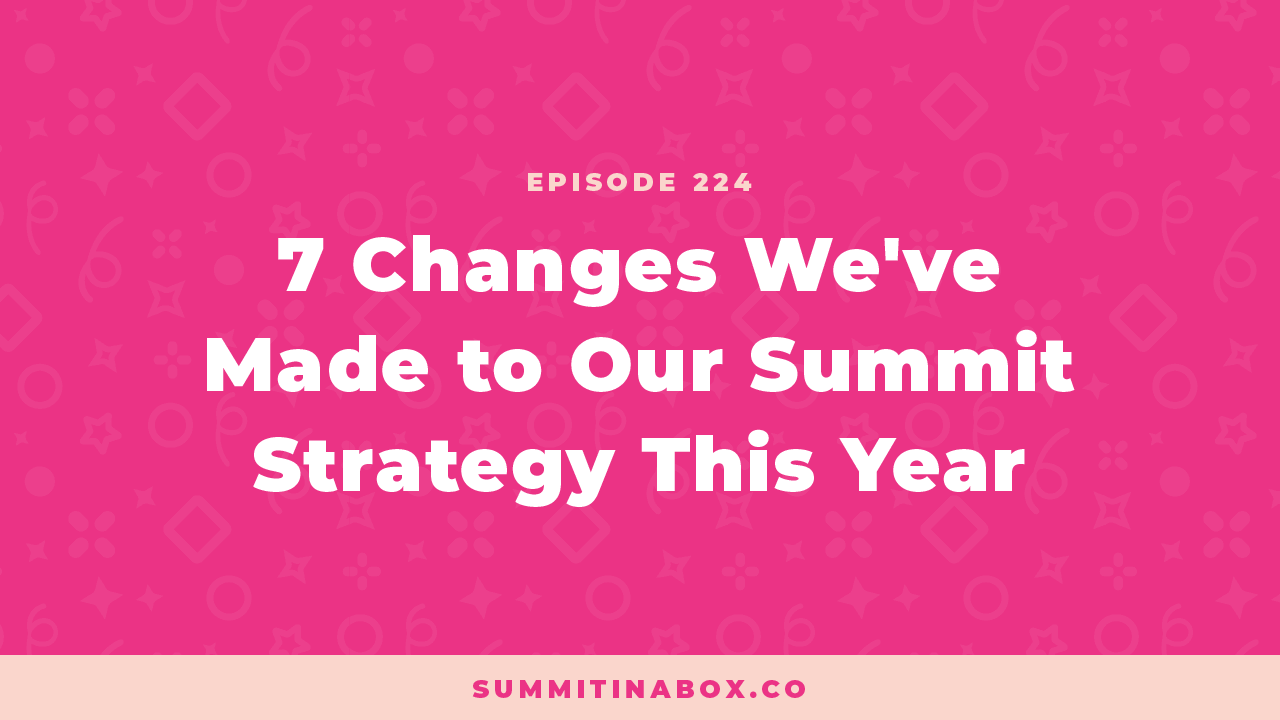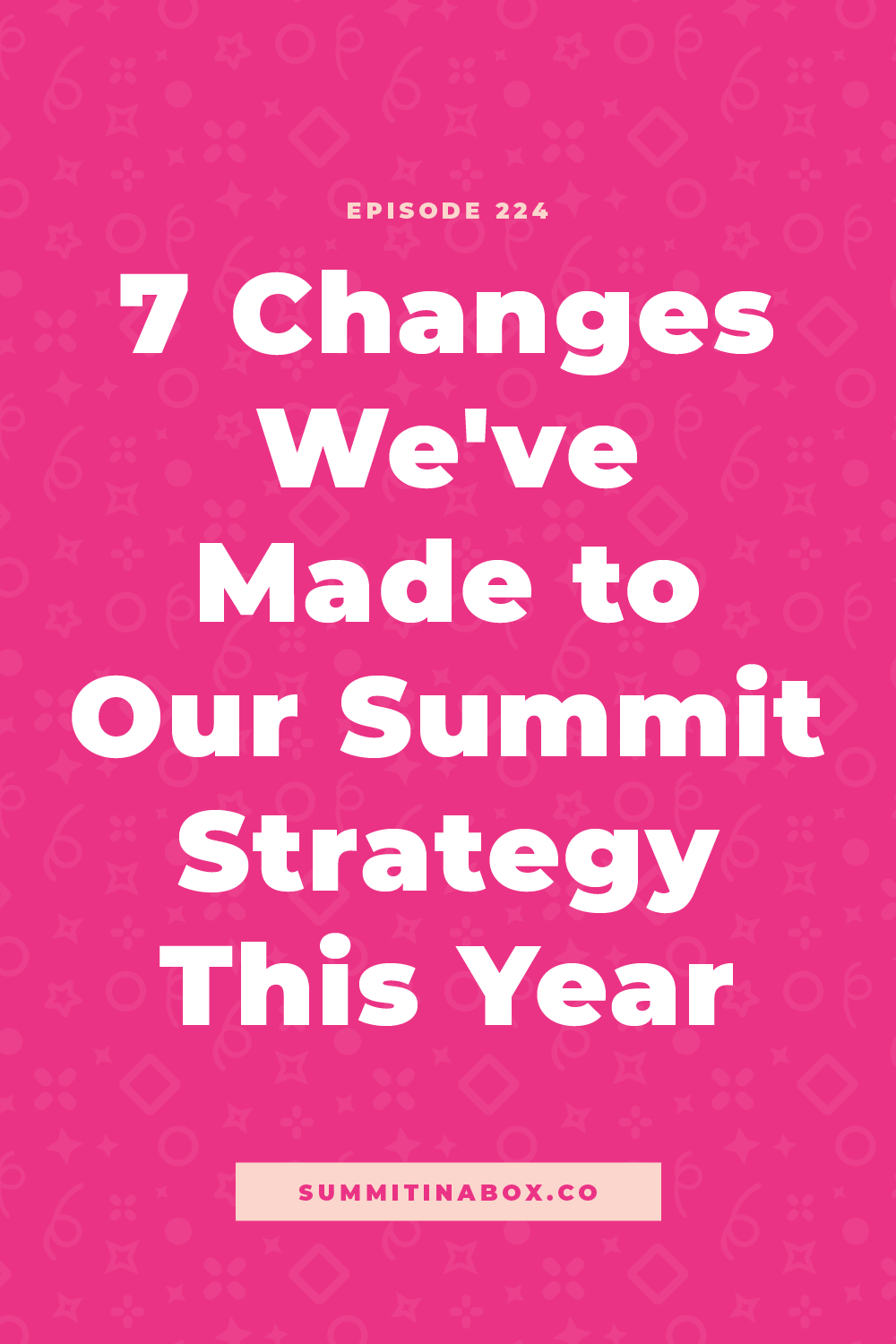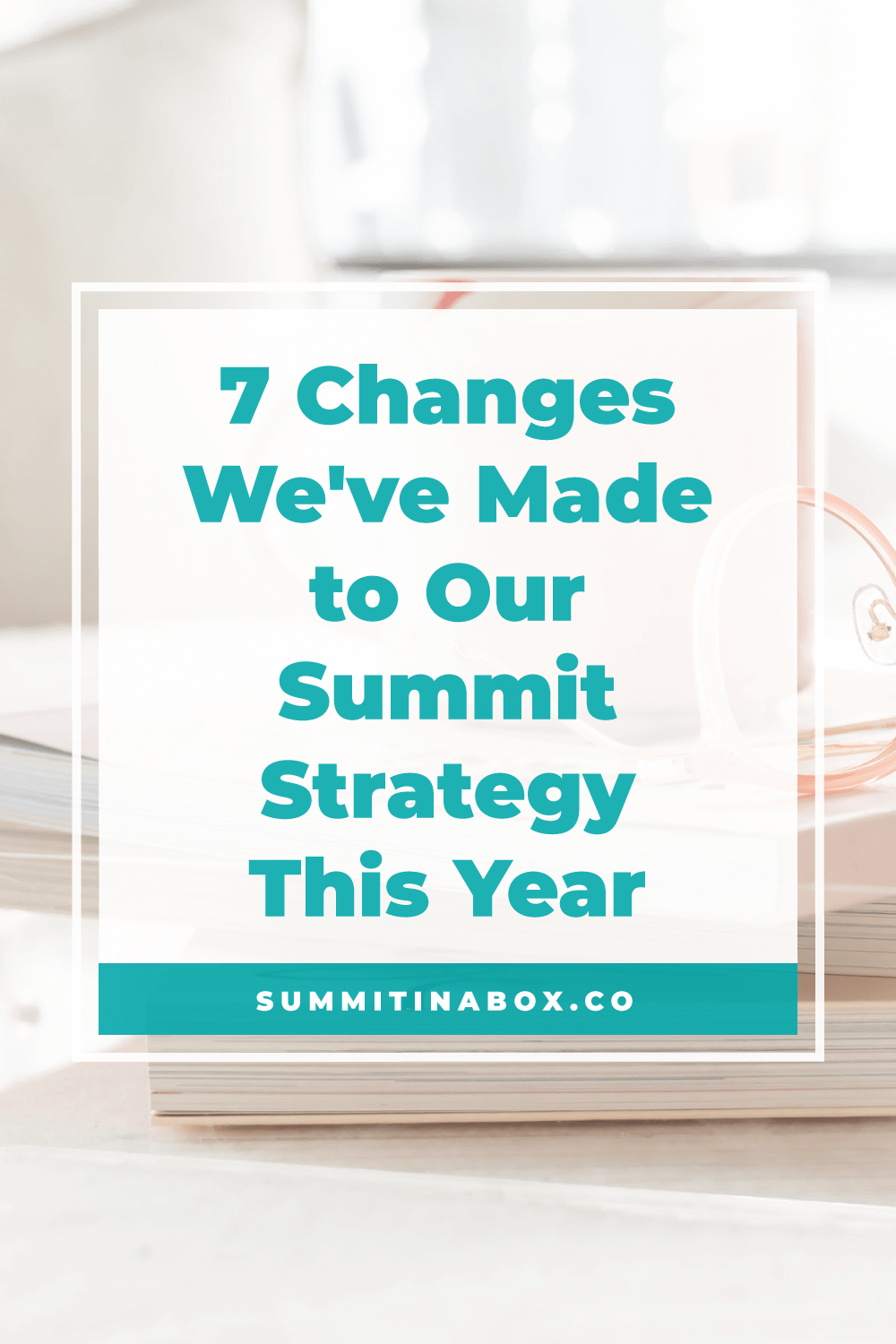7 Changes We've Made to Our Summit Strategy This Year


We are currently in a series where I'm spilling all kinds of details and lessons learned from the done-for-you client summit we produced back in January.
Last week, I shared some of my biggest takeaways, and today, I'm taking that a little further and talking about changes we're making to our summit strategies based on:
- Things we learned when producing our client's summit
- Our experience when we hosted our December 2022 summit
- Results we are seeing with our Accelerator clients
I shared some of these things when I talked about how virtual summits evolved in 2022. But these last two events we produced have led me to believe in those changes even more fully.
By the end of this episode, you'll walk away with a new outlook on at least a couple of the “standard” virtual summit strategies out there, and be able to decide if these changes are right for you too.
There's also lots of good stuff coming like:
- episode 225 where I talk about The Truth About Launching a Membership Through a Virtual Summit
- episode 226 where I share What Surprised Me Most About Producing a B2C Virtual Summit
- episode 227 where we went Behind the Scenes of Offering Done-For-You Virtual Summit Production
Listen to the episode
Simple Changes You Can Make Right Away
I want to start off with a couple of simple changes that are going to be quick and easy for me to explain that you can easily implement right way. From there, we'll dive into some more in-depth things we're changing.
Ditch the chat boxes
I’m no longer recommending chat boxes for pre-recorded summit presentations.
Back in the beginning, I used to recommend that pre-recorded presentations be dripped out hour by hour throughout the day and to use the live chat box for speakers and attendees to interact. It worked wonderfully!
But about 4 summits ago, we shifted our strategy to release all prerecorded presentations at the same time in the morning. That way, whenever someone has time throughout the day to watch summit presentations, they can watch any of them, without having to sit and wait for them to go live hourly.
I want my summits to be accessible for people living busy lives like we all are, but based on this new way of releasing presentations, a chat box just doesn’t work. People are generally most excited right when they go live, and they're not going to necessarily wait around for scheduled time to hang out in a chat box.
If you’re going to keep dripping presentations, hour by hour, and know you'll have a summit of at least 2-3000 people, maybe chat boxes will work for you, but otherwise, I recommend ditching the chat box strategy.
Here's what I recommend instead:
Have a thread for each presentation in your summit community where attendees can interact with speakers. I use a Facebook group, and each morning I'll add a post where attendees can put questions for each presentation and link to that specific thread on the presentation page. It is not quite as interactive, but at this point, I don't think it's worth the effort to set up chat boxes, advertise them, schedule them, and ask the speakers to be there live with the level of chat box engagement we've seen recently.
Host shorter events
The next simple change I'm making is to host shorter events. Five-day virtual summits have been the standard for a while, but they're just too long. I have not heard anyone recently say that they are so glad they hosted a five-day summit. By day 4, the host wants it to be done, attendees are losing interest, and speakers’ results are decreasing. Because of that, you lose momentum for your launch.
Our clients’ summit was five days, and all of us were tired by the end. In the summit we hosted earlier this year, we had a three-day summit with 2 days of presentations and the last day was engagement-building with interactive sessions and our launch day, and that felt like a good length.
So moving forward, 3-4 days are what I recommend and what I plan to keep doing.
Incorporate more live sessions
This may be more personal preference, and it might also be audience specific, but the next change I'm making is to incorporate more live sessions. A lot of summits I see for online business owners and course creators have low engagement, and unless you have an event with a really unique positioning that stands out and gets people to show up and engage, live events might not always make sense for this audience.
However, for the summit we hosted for our client in a B2C niche that wasn't familiar with summits, they only had one live session, but the engagement for that one blew the rest of the presentations out of the water. The comment section was hard to keep up with, people were buying the book he was promoting, and they loved it.
Moving forward, I'm going to see how we can experiment with leveraging live sessions and incorporating them into the prerecorded summit model moving forward.
Personally, I still have zero interest in running a totally live summit, but there is something special about having live videos built in strategically.
I recommend that our clients leverage the results and engagement we saw in their live sessions for their next event, and do something like a Daily Live Sponsor Spot with really fun and unique positioning to drive people in. I think that will do really well for them and their sponsors, and when your sponsors get results, that means you can charge even more next time.
Consider what kinds of unique live sessions you can add to your event, whether it's sponsors, you, or speakers you want to highlight. If it's not something that's going to stress you out, then it's something to think about. It can really add a unique and fun element to your event.
Create custom sponsor packages
The next change I recommend is to have custom sponsor packages versus having set packages that you just send out in an email. This isn't exactly a change to our sponsorship strategy, but something I'm emphasizing more.
In 2021 we had Nicole Batey from Fempreneur Online come into our programs and teach her sponsorship strategy for us. And in that, she recommended from the very beginning to go with custom packages for sponsors. But overall, I've seen people do a mix, and I've done a mix, of using set packages versus customizing them.
But this client summit we hosted really drove home how important custom packages can be, depending on the types of sponsors you're reaching out to. If you're reaching out to other people in the digital marketing space, like you and I, you might be able to get away with set packages.
If they're familiar with summits, they easily see and understand that value, and they probably know that they can come back and negotiate what's included and tweak the package to be what they want.
But with this client summit, the companies I talked to were completely new to the idea. Some said they're brand new to online marketing. Some didn't even know what a summit was, and no idea how it worked.
With those people, the set packages with big price tags totally backfired. If they don't understand the strategy, why would they want to dish out $1000s of dollars? By the end, after lots of conversations with sponsors, I figured out that a small, super-focused package that honed in on one key outcome and activation for that sponsor was better for these types of companies.
When I started presenting those types of packages instead, that's what converted.
For example, we had a summit goodie bag full of discounts for products that all attendees could grab. One sponsor just wanted a feature in our goodie bag. One sponsor knew they could sell their thing if they just got in front of attendees.
For me and my clients, we're going to be a lot more intentional with how we're approaching sponsors, and what we send in that initial pitch based on what we can learn in a call with them.
Personalized and direct speaker communication
On to the next change, which is more personalized and direct speaker outreach and communication.
Overall, my approach to speaker communication ties in tightly with my values of caring about people over profits and valuing the people and their presentations more than their email list.
I'm not going to send someone a million follow-up emails if I can't get a hold of them. I'm going to stop because I don't want to be annoying. And also, if I have to work my booty off to get an initial response, that's probably going to carry on throughout the summit.
I'll do some follow-up. But I'm not going to harp on them about it.
Same with the speaker promotion for this client’s summit. We had quite a few speakers who just did not promote and our client was hard on me for not being harder on the speakers. But I let them know that part of our goal here is to build connections with the speakers, and getting rude with them and pressuring them to promote, does not do that. Let's just take it as a lesson that we don't collaborate with this person again.
I've also seen overall speaker interaction dwindle, at least in my B2B summits, over the last few years. There's a little trick I tried in my last summit that definitely increased speaker engagement, but overall, as people speak in more summits, their engagement and the amount they care about it goes down.
I've found that personalized and direct outreach to your speakers is one way to really combat this issue and increase speaker interaction and engagement.
This could look like:
- Sending personalized emails with custom swipe copy
- DMing speakers who weren't answering or engaging with emails
- A group message you start in Instagram messenger letting them know when you send out emails and the key things they want to take away
- Text message reminders
I'll be getting more intentional about getting those results and response rates back up to where they used to be moving forward.
Send more emails
The next strategy I'm changing is to send more emails, across the board. In the last episode, I shared some of the live changes we made to our strategy after seeing that all-access pass conversion rates just weren't where we expected, especially in the beginning. And several of the changes we made meant sending more emails to speakers, attendees, and people not signed up for the summit yet. I'm going to continue that in our own events and tie it into our strategy more.
I know there are people out there on both ends of the “how many emails is too many emails” spectrum. I heard someone recently go off about how if you send one email, and it's not interacted with, you're being abusive by sending more emails.
I know there are also some people who think you should send multiple emails every single day during a launch or event. I tend to fall in the middle of those. I tend to be more concerned about sending too many emails than not enough because I just don't like the idea of annoying people.
But based on the results we saw from adding in extra emails, I think it's worth it to see if it feels like it's an alignment for you to send more.
- Can you talk about your all-access pass or an aspect of it more directly in a new email?
- Is there a chance people missed an important detail that was very deep inside your daily email announcement?
- I also always consider whether something needs an “opt-out from this campaign” link.
But overall, I'm going to experiment with the idea of adding more emails to our campaigns.
To give you a concrete example of this: right now we do an early bird price for the all-access pass until day one of the summit. Currently, our strategy is that the day before the summit is when we do our kickoff call. That's when the price increases. We use to send two emails that day about joining the kickoff call that also mentioned that the price was increasing, and that was it.
Really, the price increase deserves at least one email of its own, if not more. So adding more direct promotion of that to make sure no one misses that opportunity is something that I'm going to be doing.
Start with templates, but let attendees do the talking
The last change I'm going to be making is to start with templates, but then let the attendees do the talking. I have this moment in every summit I host where I am just so thankful to my past self for deciding to make a program about virtual summits with every template you could ever need because I use them!
I don’t make anything from scratch because I can grab a template out of my own program. Our recent two events highlighted to me that using templates, although they should make our job easier, they should not make us lazy.
If you're someone who does copy/paste, fill in the blanks, and you're done, I definitely encourage you to take some time for additional customization.
Beyond making your event more unique to your business, I also saw how important it was to let the attendees and data do the real talking and make customizations based on that.
Our templates have been proven literally hundreds of times, but in the act of working to improve conversion rates, I learned so much about ways that our templates needed to be changed, at least for this particular summit and audience, by looking at user data, heat maps, and website recordings,
Right now, we're actively working with some of our other clients to see if those changes need to be made to our templates as a whole. And I do think there are audiences out there that no changes would be needed for, but it's worth it to watch and to test and to figure it out for sure.
- Where do people have questions?
- Where are they confused when it comes to how your event works or how to use your website?
- Where are they hesitating on a page or losing interest and leaving?
You can see that information with a tool like Hotjar. Our templates are wonderful, but no template out there can cover every single situation and every single niche absolutely perfectly. So it's up to you to take the initiative to make tweaks as needed for your summit and then watch the data.
No strategy remains unchanged forever
My biggest takeaway is that no strategy remains unchanged forever. Summits are so powerful, and I think they will remain powerful, but it's not a strategy that's going to stay static. I need to stay on top of that, but so do you. Go into every event as if it were purely a learning experience that you're also going to happen to make some money on. This will help you continue to make your events bigger and better every time without getting lazy about it, and I will continue to do the same.
If you're enjoying what you're learning here, you will love the Summit to Sales training series. This free series is for course creators, membership site owners, and group program coaches who need a high volume of leads to hit big sales goals. The free Summit to Sales training series will show you how hosting virtual summits can become your most effective lead-generation strategy, cash injection method, and lead to a long-term and reliable increase in sales of your signature offer. Get started on the path to not only continue the success you found but grow it with the virtual summit.
Resources
- Hotjar
- Nicole Batey from Fempreneur Online
- Episode 69: The Problem With Requiring Speaker Promotion + How To Do It Right
- Episode 158: How to Make Non-Transactional, Ick-Free Speaker Connections with Michelle Warner
- Episode 205: How Virtual Summits Evolved in 2022
- Episode 223: Key Takeaways from Our Done-For-You Client Summit
- Episode 225: The Truth About Launching a Membership Through a Virtual Summit
- Episode 226: What Surprised Me Most About Producing a B2C Virtual Summit
- Episode 227: Behind the Scenes of Offering Done-For-You Virtual Summit Production
- Summit Host Hangout Facebook group
- Launch with a Summit Accelerator
- 6-Figure Summits Workshop Bundle
Pin it for later!




